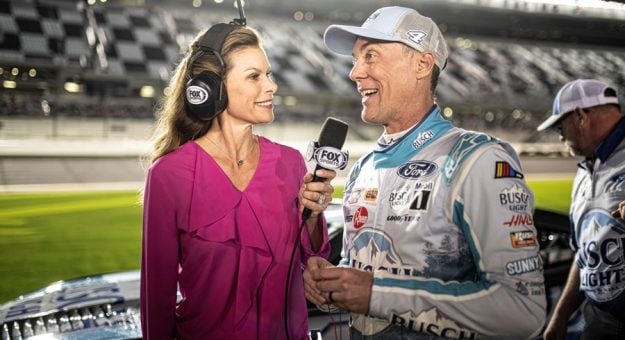Click here to read Part I: No More Firsts, or here to read Part II: On The Cusp.
While female talent is still difficult to find on the starting grids at some of the country’s most elite races, women are steadily pushing boundaries off the track.
For example, rewind to the summer of 2021 and you’ll find a three-race streak in the NTT IndyCar Series where at least one female engineer was present in the winner’s circle.
It began June 12 on the streets of Belle Isle in Detroit, as Honda Performance’s trackside race engineer Nicole Rotondo joined in the victory celebration with Marcus Ericsson following the first race of the Chevrolet Detroit Grand Prix.
The pattern continued the following day with Arrow McLaren SP engineer Kate Gundlach, who enjoyed a win with Pato O’Ward during the second race of the Detroit Grand Prix. The next weekend, simulation engineer Danielle Shepard helped Alex Palou secure victory for Chip Ganassi Racing at Wisconsin’s Road America.
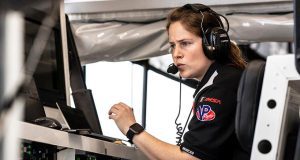
Last March, Shepard made headlines again as a lead race engineer for CGR in the IMSA WeatherTech SportsCar Championship.
She added her name to a short list of female engineers who have triumphed at the illustrious Mobil 1 Twelve Hours of Sebring after leading the No. 2 Cadillac DPI-V.R. team to victory at Sebring Int’l Raceway in Florida.
“I think that’s where there’s the most opportunity,” commented Lyn St. James, former IndyCar and sports car driver.
“I think you will see more and more women integrated into the engineering area. There’s now a history, as there has been a history of female drivers.”
With her seven starts in the Indianapolis 500 and other accolades, St. James is considered one of the most successful females in the history of motorsports. But as a former racer, she has a realistic understanding of how hard it is for a woman to make it as a driver.
Along with engineering, a second facet of the racing industry in which St. James believes women have strong prospects is management.
To illustrate this point, consider the story of one woman who has reached a premier leadership role at a highly respected race track. In 2018, Julie Giese became the sole female track president on the NASCAR circuit when she assumed the role at Arizona’s Phoenix Raceway.
But her journey to operating the one-mile track was anything but conventional.
After growing up on a humble Wisconsin dairy farm, Giese initially presumed the remainder of her life would be spent in agriculture. However, her lifelong fandom of racing took hold and steered her career direction after college.
Despite receiving a slew of rejections from race tracks to which she applied, Giese found a home at Watkins Glen (N.Y.) Int’l in 2001 as senior manager of public relations.
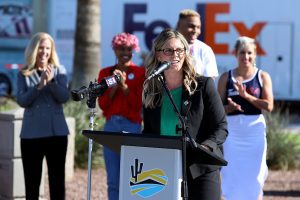
As she climbed the ladder, Giese led a number of substantial projects at iconic race tracks around the country — including a $400 million renovation of Daytona Int’l Speedway. She also led a $178 million renovation effort at Phoenix Raceway.
“I grew up loving racing, but I never thought it was something I would ever work in, honestly,” Giese said.
While she admits female drivers are easily the most visible representation of women in motorsports, Giese is quick to clarify that there are numerous avenues through which women can become involved.
“Once you get into this industry, you start to learn about the different opportunities and see paths that you never thought were possible. That’s what’s so critical for getting anyone involved in this sport,” Giese said. “Whether it’s being a promoter, in the accounting field, in the law field or in the engineering field.”
In November, Giese was succeeded in her position at Phoenix Raceway by Latasha Causey. Causey became the first female African American track president in NASCAR, while Giese is now president of NASCAR’s Chicago Street Race project.
It’s worth noting that the range of motorsports management opportunities is quite diverse.
Examples of how women have established themselves in the industry include as public relations personnel (Sara Slaughter, John Force Racing, director of PR), media members (Jamie Little, NASCAR on FOX, pit reporter), race directors (Mady Ayesh, NHRA, South Central Division director) and team owners (Beth Paretta, Paretta Autosport).
One female in particular has seen and experienced more than most, due to lifetime ties to NASCAR.
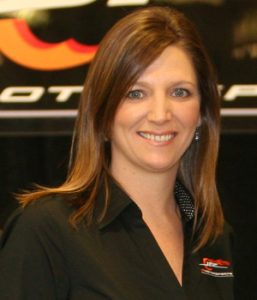
Kelley Earnhardt Miller, daughter of the legendary Dale Earnhardt, has managed her brother’s (Dale Earnhardt Jr.) career for the past 22 years.
As Earnhardt Jr. has long since retired from full-time driving, Miller’s efforts are now focused primarily on running JR Motorsports, where she was promoted to CEO in September.
With four NASCAR Xfinity Series teams to manage, much of Miller’s time is dedicated to the business side of the sport and directing the 127 employees who fall under her jurisdiction.
However, Miller’s history in racing goes far beyond the position she currently holds.
During her teenage years, Miller was a weekly competitor on the track. She frequently wheeled her stock car at Myrtle Beach (S.C.) Speedway and Hickory (N.C.) Motor Speedway, exhibiting her Earnhardt-esque driving talent against the male-dominated field.
“I raced against other 21-year-old boys and a lot of 40-year-old men,” Miller said. “I never raced against women. They just weren’t there.”
Since the ’90s, Miller has witnessed women’s roles in the sport go through a transition, as more females have flooded into the field. While credit is certainly due to Miller for what she’s accomplished in the business realm of racing, she admits she’s had a “leg up” on others, simply because she’s an Earnhardt.
“There’s a lot of instant credibility that comes with that name,” Miller said. “But I long for the day that we don’t have to have these conversations, the day where it doesn’t matter whether you’re a male or female trying to do it.”
As a mother of three, Miller also recognizes that women often have additional factors to consider when deciding on a life in motorsports. The phrase “it takes a village” has rung true for Miller, as she’s had to balance raising her kids with advancing her career.
“Maybe you can’t be a female race car driver and be a mom when you want to be. It would be hard to be a competitive driver and do that,” Miller suggested. “You’ve got to decide where certain things lay for you in terms of how hard you want to go after something.”
Juggling motherhood and racing is by no means impossible, though Miller’s opinion on the matter is poignant. From a driver’s perspective, sentiment toward the topic of family life is fairly mutual.
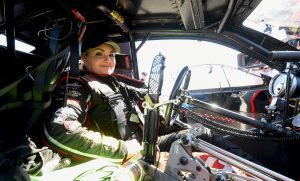
When asked at what point she would consider retirement, NHRA Pro Stock driver Erica Enders answered, “The only reason I would ever stop racing would be to have a family. That’s the one downside of being a female out there, is you’d have to take a year off for all that.”
And yet, the complication hasn’t stopped the 39-year-old Enders from becoming one of the winningest female drivers in NHRA.
The Pro Stock powerhouse has collected five world championships over the last 10 years.
As for a third area of opportunity for women in racing, St. James points to the media, where Little is an exemplary illustration of a passionate fan turned motorsports media professional.
When Little entered the television broadcast scene post-college, she was determined to be involved in racing. After riding dirt bikes with her dad as a little girl, Little quickly became hooked on the world of Monster Energy AMA Supercross as a teenager.
“I wanted people to know what (the riders) go through as athletes. These are like 16-year-old guys that were homeschooled and breaking their bodies just to try to make it to the pro levels,” Little explained. “I was so attracted to it that I started reading dirt bike magazines … and of course, I watched racing on TV.
“I remember thinking, I don’t know what I want to do with my life, but there’s something that draws me into this TV world. There aren’t any women doing it for one, and I knew I could do a better job than the guy I was watching.”
At 18 years old, while enrolled in college in San Diego, Little befriended a local ESPN reporter. She began tagging along to races, learning the tricks of the trade and, as one thing snowballed into another, Little worked her way straight to the position she’d hoped to reach.
Her national broadcasting debut came during a Supercross race at Daytona Int’l Speedway in 2002 — which also solidified Little as the first female to cover Supercross live on-air.
But her breakthroughs didn’t stop there.
In 2004, Little became the first female pit reporter to work the Indianapolis 500. In 2015, she became the first woman to cover both the Daytona 500 and Indianapolis 500 in the same year.
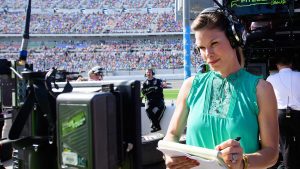
In 2021, Little assumed the role of play-by-play caller for the ARCA Menards Series, the first female to hold a lead announcing position for a national racing series.
Yet, Little shrugs off the weight of the milestones.
Her mentality has never been shaped around “being the first woman” to do something. Rather, it’s simply been centered on doing her best.
“That’s what it’s all about — doing a good job to prove to fans, to prove to television producers that, give a woman a shot, and they won’t let you down,” Little said.
“My responsibility is to prove that I can do it and that women belong there.”
Over the last 17 years, Little has built a comfortable home in NASCAR.
She’s also raised two kids along the way with her husband, Cody Selman. Little has certainly “arrived” at her dream career destination. But perhaps even more meaningful is the fact that she’s now surrounded by women while doing it.
“When you look around and you see the female reporters, female writers or TV crew, there’s so many more women in the garage than there used to be,” Little said. “We’re not where we need to be, but we’re making progress.”
From engineers and tire specialists, to track presidents and team management, to media members and PR representatives — the doors are wide open for more women to enter motorsports.
As well, female drivers continue to gain speed and surge through the ranks, from dirt tracks to the drag strip.
A world of opportunity awaits.
Click here to read Part I: No More Firsts, or here to read Part II: On The Cusp.
This story appeared in the May 24, 2023, edition of the SPEED SPORT Insider.
